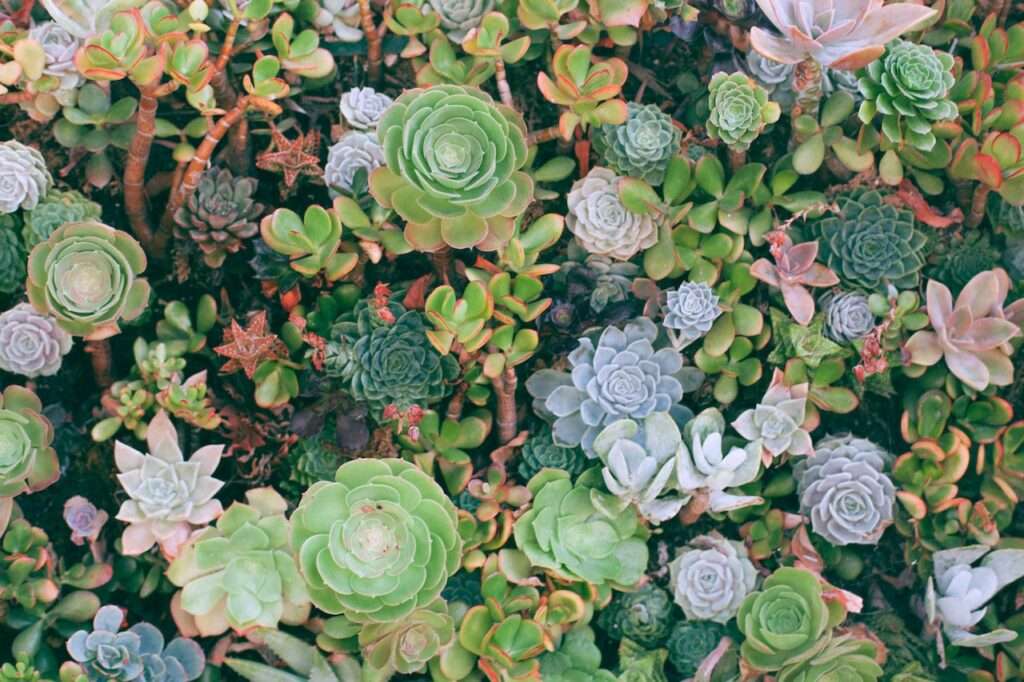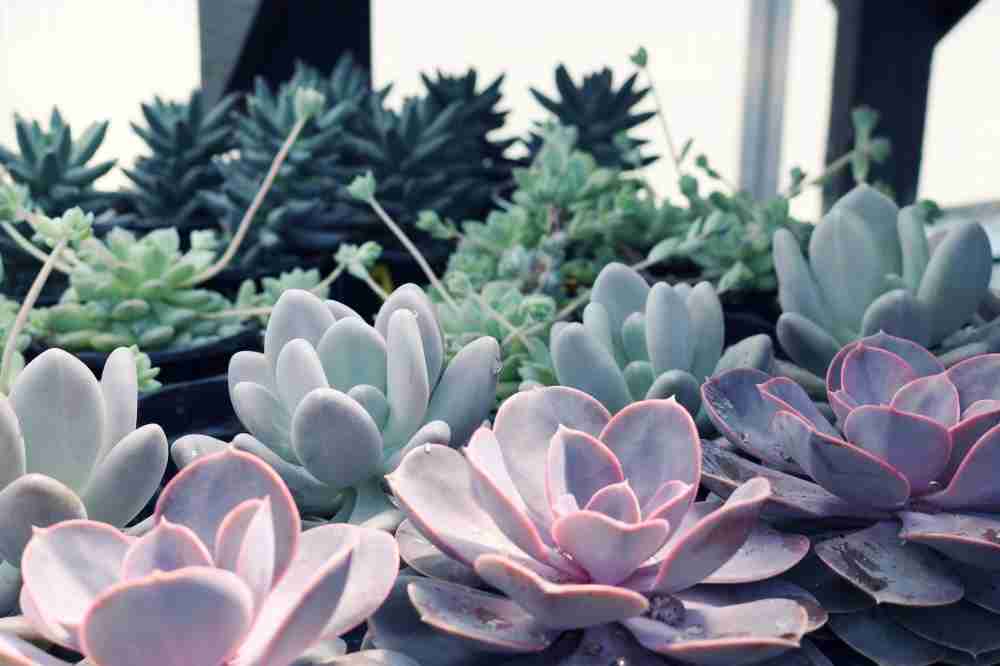Do you think you have all the green in your garden space and want to add some variety of colours to make the land space look more beautiful and attractive? Purple Succulents can make a difference.
To add a touch of vibrancy and uniqueness to your indoor or outdoor garden, introducing different colours is the key factor of consideration.
Look no further than purple succulent plants. With their striking hues and captivating beauty, these plants are sure to become the centrepiece of any space.
In this article, we will explore 15 unique and eye-catching purple succulent plant ideas that will leave you awe-inspired.
Introduction: The Allure of Purple Succulent Plants
In this Article
Because they can flourish in a variety of conditions and require little upkeep, succulent plants have become extremely popular in recent years. Purple succulent variations have won the hearts of plant lovers among the broad variety of succulents. Purple succulents are an alluring option for both indoor and outdoor gardens due to the beautiful colours of purple’s ability to infuse any place with a feeling of mystery and grandeur.
if you like to check out the scientific name of the succulent family. check this out Succulent Scientific Names
The Purple Succulent’s Symbolism
Purple is frequently linked to elegance, creativity, and spirituality. Purple succulents are a symbol of individualism and self-expression since the colour represents individuality. Purple succulents can add a compelling ambience to your landscape and offer a visual feast for the eyes.
What are Succulent Plants?
Succulents can withstand dry circumstances by storing water in their leaves, stems, or roots. They come in a variety of forms, dimensions, and hues, including the hypnotic hues of purple. These plants are a great option for novice and expert gardeners because of their propensity to survive in various environments and their resistance to neglect.

Succulent Plants Types and Ideas to Add to Your Garden
1. The Midnight Beauty by Echeveria, “Black Prince”
The Echeveria “Black Prince” is one of the most beautiful purple succulent plants. This plant has rich burgundy, rosette-shaped leaves that resemble a flower that is blooming in the moonlight. Anyone who looks at it will be mesmerised by the contrast between the dark purple exterior and the light green interior.
2. The Jewel of the Desert: Graptopetalum Amethystium
The Graptopetalum Amethystium, often known as the Lavender Pebbles, is a true gem of the desert with its delicate, lavender-coloured leaves. These dense rosettes of succulents have the appearance of being embellished with small amethyst stones. It stands out in any group of succulents thanks to its distinctive hue and texture.
3. The Sedum ‘Purple Emperor’: Royal Elegance
With its dark purple, nearly black foliage, the Sedum ‘Purple Emperor’ lives up to its name and emanates imperial grandeur. The leaves of this succulent resemble tiny, elongated crowns, which adds to its magnificent appeal. The “Purple Emperor” commands admiration whether it is grown in a garden bed or shown in a container.
4. The Black Rose, Aeonium arboreum ‘Zwartkop’
The Black Rose, sometimes referred to as Aeonium arboretum ‘Zwartkop,’ is a show-stopping succulent. An arrangement of tiny black roses would mimic its velvety, burgundy-black rosettes. This beautiful plant is a favourite for gorgeous succulent arrangements since it stands out dramatically against lighter-coloured succulents.
5. The Rosette Wonder: Echeveria ‘Lola’
The Echeveria ‘Lola’ is an alluring succulent with rosettes that turn deep purple at the borders from light lavender in the centre. The plant has an ethereal charm due to the delicate, powdery appearance of its leaves. Lola is a hardy succulent that grows well indoors and out, making it a favourite among succulent growers.
6. Moonstones, Pachyphytum oviferum
The Moonstone or Sugar Almond plant, Pachyphytum oviferum, has plump leaves that are lavender and pastel purple in colour. Its plump, spherical leaves have the alluring shine of the moon, looking like small diamonds. This succulent is an eye-catching addition to any collection of succulents thanks to its distinctive texture and colour.
7. The Wandering Jew, Tradescantia pallida ‘Purpurea’
A trailing succulent with vivid purple foliage that gives a pop of colour to any garden is the Tradescantia pallida ‘Purpurea’. It is the perfect plant for ground cover or hanging baskets because of the cascade impression its long, slender leaves produce. This sturdy succulent flourishes in direct sunlight and needs little upkeep.
8. The Blue Chalksticks (Senecio mandraliscae),
The Senecio mandraliscae, sometimes known as the Blue Chalksticks, has powdered blue-green leaves with a purple undertone, however, they are not entirely purple. This succulent grows in dense, trailing bunches with a rainbow-like appearance. A touch of originality is added to any environment by the drought-tolerant succulent known as the Blue Chalksticks, which grows best in sunny areas.
9. Grafted Moon Cacti: Vibrant Partners
These striking succulents, called Grafted Moon Cacti, are available in various hues, including purple. These little, spherical cactus stand out against their green bases with vivid purple tops. Grafted Moon Cacti can be grown indoors or outdoors and offer a splash of colour to any area. They are frequently described as living art pieces.
10. The Fiery Display: Euphorbia tirucalli “Firesticks”
The succulent shrub Euphorbia tirucalli ‘Firesticks’ has slender, branching stems in red, orange, and purple hues. It is the centre of attention in any garden thanks to its flaming hues, which resemble a raging inferno. This succulent is a hardy and alluring option for succulent aficionados because it can withstand drought and thrive in warm areas.
11. The Rare Delight of Aloe ‘Cynthia Giddy’
The unusual succulent aloe ‘Cynthia Giddy’ has rosettes of light green leaves that become gorgeous purple when exposed to sunlight. It is a highly desired addition to succulent collections due to its small size and captivating colours. The durable succulent “Cynthia Giddy” gives a touch of elegance to any setting while requiring little maintenance.
12. The amazing Tillandsia xerographica is an air plant.
The King of Air Plant, or Tillandsia xerographica, is a captivating succulent that doesn’t need soil to grow. Its curling, silvery-grey leaves form an alluring rosette-like pattern. Despite not being purple, this air plant adds intrigue and depth to arrangements by harmoniously blending with purple succulents.
Conclusion
A mesmerising sanctuary of colours and textures can be created in your yard by adding purple succulent plants. Every one of these 15 distinctive and eye-catching succulents, from the enigmatic and ominous Echeveria “Black Prince” to the regal elegance of Sedum “Purple Emperor,” adds its own charm and attraction. These alluring purple succulent plant ideas will infuse your yard with a sense of colour and individuality.
FAQs
1. Can purple succulents survive outdoors?
Yes, a lot of purple succulents can survive and even thrive outside. However, it’s crucial to take into account the unique maintenance needs of each succulent and confirm that your climate is conducive to their growth.
2. Do purple succulents require special care?
The maintenance requirements for purple succulents are typically the same as for other succulent kinds. They favour soil with good drainage, lots of sunlight, and infrequent watering. To guarantee each plant grows to its full potential, it’s always a good idea to learn about its particular requirements.
3. Can I propagate purple succulents?
Yes, stem cuttings or leaf propagation are simple ways to multiply most purple succulents. By doing so, you can add to your collection of succulents and introduce others to their beauty.
4. How often should I water purple succulents?
Like other succulent kinds, purple succulents don’t need much water. It’s preferable to water them seldom and let the soil dry up in between water applications. A succulent and its carer may experience pain and misery as a result of excessive watering, which may have the negative effects of root rot and other plant diseases.
5. Where can I purchase purple succulents?
Purple succulents can be found at local nurseries, garden centres, or online plant retailers. Additionally, succulent enthusiasts often trade or sell cuttings and propagated plants through online communities and social media platforms.
